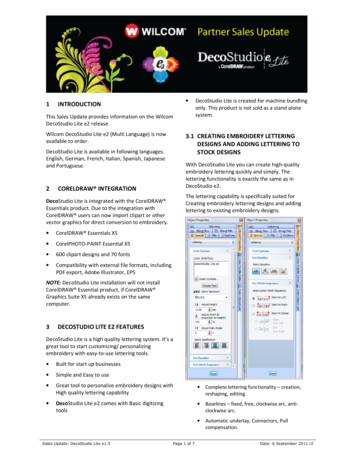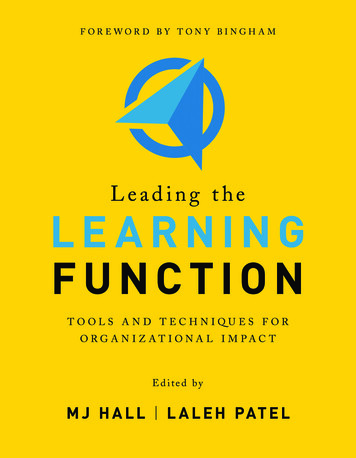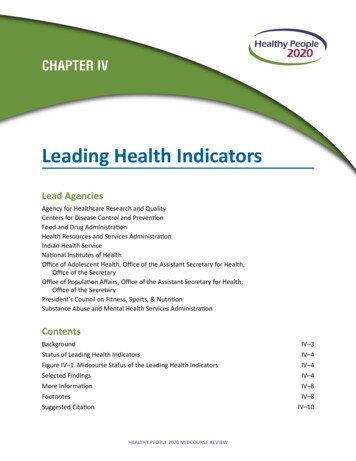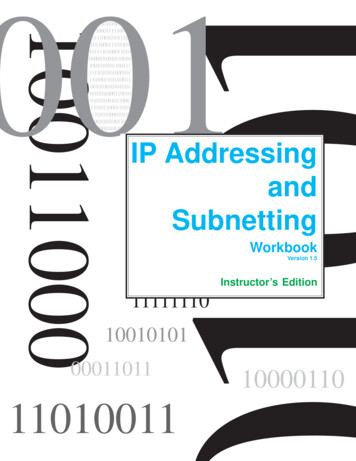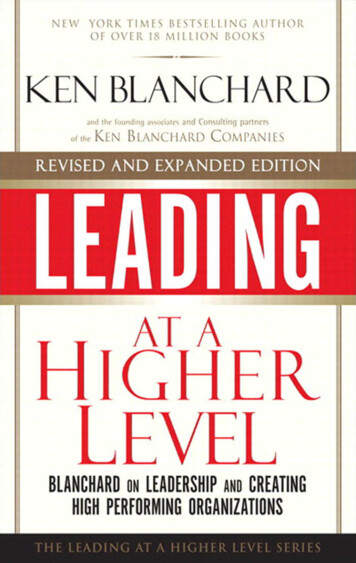
Transcription
Praise forLeading at a Higher Level“At Southwest Airlines, we have always strived to lead at a higher level.We truly believe that profit is the applause you get for taking care of yourinternal and external customers. We have always insisted upon a happy,carefree, team-spirited—yes, even fun—working environment, whichwe think results in motivated employees who will do the right thing fortheir internal and external customers. Reading this book will make apositive difference in your organization.”Colleen C. Barrett, President Emeritus, Southwest Airlines“This is not just theory. It is the real stuff, tried in dozens of companiesbig and small. It represents the most concise, practical, and effectivethinking on leadership around. Plainly said, this works.”Gary Crittenden, Managing Director, Huntsman Gay Global Capital,former CFO of Citigroup and American Express“Leading at a higher level is a must today if leaders are to rebuild trustand credibility, as we are doing at Tyco. This book will teach you how.”Eric Pillmore, Senior Vice President of Corporate Governance,Tyco International“Leading at a Higher Level translates decades of research and 30 years ofglobal experience into simple, practical, and powerful strategies to equipleaders at every level to build organizations that produce bottom-lineresults. At Nissan, we have made these principles a core part of our leadership philosophy, better equipping our managers to bring out the greatenergies and talents of our employees.”Jim Irvine, Vice President of Human Resources,Nissan North America
The concepts in Leading at a Higher Level have been used by high performing organizations around the world, including:Abbott LaboratoriesAMF BowlingWorldwide, Inc.Anthem Blue Crossand Blue ShieldApplebee’sInternational, Inc.Bayer AGBig Lots Stores, Inc.Biogen Idec Inc.Bose CorporationBowater IncorporatedBurger King Callaway GolfCompanyCaterpillar Inc.Cellular OneChick-fil-A , Inc.Children’s HospitalThe Coffee Bean andTea Leaf Comerica IncorporatedCompaqCompUSA ConocoPhillipsDomino’s PizzaDow CorningCorporationEnergy NorthwestExxon MobilCorporationFairmont Hotels &ResortsFedEx Kinko’s Officeand Print ServicesFireman’s FundInsurance Company Foster FarmsGenentech, Inc.Georgetown UniversityHilton HotelsCorporationHome DepotHost Hotels & Resorts,(formerly knownas Host Marriott)Hyatt CorporationJack in the Box Inc.Kennedy Space CenterKrispy KremeDoughnut CorporationL’OréalMattel, Inc.Marriott InternationalMCI, Inc.Merck & Co., Inc.The Michelin GroupMicrosoft CorporationNabiscoNissan Motor Co.Northrop GrummanCorporationNovartis AGPepperdine UniversityPolaris IndustriesThe Ritz-Carlton HotelCompanyRoyal Caribbean CruisesLtd. Safeco CorporationSan Diego PadresS.C. Johnson & Son, Inc.Six Continents RetailSony Corporation ofAmericaStaples, Inc.Toshiba CorporationToyota Motor CorporationTRW Automotive Inc.Tyson Foods, Inc.UCLAUnited States PostalService UPS VerizonVictoria’s SecretWal-Mart Stores, Inc.Washington StateCriminal Justice TrainingCommissionWD-40 CompanyWells Fargo & CompanyWendy’s International,Inc.Yellow Pages (GTE)
LEADINGAT AHIGHERLEVELRevised and Expanded Edition
CONTRIBUTING AUTHORSKen BlanchardMarjorie BlanchardScott BlanchardMadeleine BlanchardDon CarewEunice Parisi-CarewKathy CuffGarry DemarestChris EdmondsFred FinchSusan FowlerBob GlaserLael GoodVicki HalseyLaurence HawkinsJudd HoekstraFay KandarianLinda MillerAlan RandolphJesse StonerDrea ZigarmiPat Zigarmi
LEADINGAT AHIGHERLEVELRevised and Expanded EditionBlanchard on Leadershipand Creating HighPerforming OrganizationsThe Founding Associates and Consulting Partnersof The Ken Blanchard Companieswith an Introductionby Ken Blanchard
Vice President, Publisher: Tim MooreAssociate Publisher and Director of Marketing: Amy NeidlingerEditorial Assistant: Pamela BolandDevelopment Editor: Russ HallOperations Manager: Gina KanouseDigital Marketing Manager: Julie PhiferPublicity Manager: Laura CzajaAssistant Marketing Manager: Megan ColvinCover Designer: Chuti PrasertsithManaging Editor: Kristy HartSenior Project Editor: Lori LyonsCopy Editor: Gayle JohnsonProofreader: Kay HoskinSenior Indexer: Cheryl LenserSenior Compositor: Gloria SchurickManufacturing Buyer: Dan Uhrig 2010 by BMC, Blanchard Management CorporationUpper Saddle River, New Jersey 07458For information about buying this title in bulk quantities, or for special sales opportunities (whichmay include electronic versions; custom cover designs; and content particular to your business,training goals, marketing focus, or branding interests), please contact our corporate sales departmentat corpsales@pearsoned.com or (800) 382-3419.For government sales inquiries, please contact governmentsales@pearsoned.com.For questions about sales outside the U.S., please contact international@pearsoned.com.Company and product names mentioned herein are the trademarks or registered trademarks of theirrespective owners.All rights reserved. No part of this book may be reproduced, in any form or by any means, withoutpermission in writing from the publisher.Printed in the United States of AmericaSixteenth Printing: March 2015ISBN-10: 0-13-701170-9ISBN-13: 978-0-13-701170-4Pearson Education LTD.Pearson Education Australia PTY, Limited.Pearson Education Singapore, Pte. Ltd.Pearson Education North Asia, Ltd.Pearson Education Canada, Ltd.Pearson Educación de Mexico, S.A. de C.V.Pearson Education—JapanPearson Education Malaysia, Pte. Ltd.Library of Congress Cataloging-in-Publication DataBlanchard, Kenneth H.Leading at a higher level : Blanchard on leadership and creating high performing organizations /the founding associates and consulting partners of The Ken Blanchard Companies. — Updated ed.p. cm.ISBN 978-0-13-701170-4 (hardback : alk. paper) 1. Leadership. 2. Organizational effectiveness.I. Ken Blanchard Companies. II. Title.HD57.7.B5612 2010658.4’092—dc222009024874
Dedicated to all leaders in the worldwho are trying every day to lead at a higher level.May you keep your energy high and knowthat what you are doing makes a difference.
This page intentionally left blank
CONTENTSIntroduction: Leading at a Higher Levelby Ken Blanchard xvSECTION I: SET YOUR SIGHTS ON THE RIGHT TARGETAND VISION 1CHAPTER 1IS YOUR ORGANIZATIONHIGH PERFORMING? 3Don Carew, Fay Kandarian, Eunice Parisi-Carew,Jesse Stoner, and Ken BlanchardThe Right Target: The Triple Bottom Line A HighPerforming Organization SCORES Every Time The HPOSCORES Model The HPO SCORES QuizCHAPTER 2THE POWER OF VISION17Jesse Stoner, Ken Blanchard, and Drea ZigarmiThe Importance of Vision Effective Versus Ineffective VisionStatements Creating a Vision That Really Works ACompelling Vision Creates a Culture of Greatness Vision Isthe Place to Start Make Your Vision a Reality Vision andLeadershipSECTION II: TREAT YOUR CUSTOMERS RIGHTCHAPTER 331SERVING CUSTOMERS AT AHIGHER LEVEL 33Ken Blanchard, Kathy Cuff, Vicki Halsey,and Jesse StonerGetting Legendary SCORES from Your Customers CreatingLegendary Service Serving Customers at a Higher Level Deliver Your Ideal Customer Service Experience PermittingPeople to Soar Wallowing in a Duck Pond Give Your PeopleWings Creating Legendary Service Requires Gung Ho People
ContentsSECTION III: TREAT YOUR PEOPLE RIGHT55CHAPTER 457EMPOWERMENT IS THE KEYAlan Randolph and Ken BlanchardWhat Is Empowerment? The Power of Empowerment HowPast History Blocks Change to Empowerment TappingPeople’s Potential: A Real-World Example Learning theLanguage of Empowerment The Three Keys toEmpowermentCHAPTER 5SITUATIONAL LEADERSHIP II:THE INTEGRATING CONCEPT 75The Founding AssociatesMatching Leadership Style to Development Level Development Level Varies from Goal to Goal and Task toTask - The Importance of Meeting People Where They Are The Three Skills of a Situational Leader Effective LeadershipIs a Transformational JourneyCHAPTER 6SELF LEADERSHIP: THE POWER BEHINDEMPOWERMENT 91Susan Fowler, Ken Blanchardand Laurence HawkinsCreating an Empowered Workforce Creating Self LeadersThrough Individual Learning The Three Skills of aSelf LeaderCHAPTER 7PARTNERING FOR PERFORMANCE105Fred Finch and Ken BlanchardEstablishing an Effective Performance Management System Partnering and the Performance Management System Partnering as an Informal Performance Management Systemx
ContentsCHAPTER 8ESSENTIAL SKILLS FOR PARTNERING FORPERFORMANCE: THE ONE MINUTEMANAGER 129Ken Blanchard and Fred FinchOne Minute Goal Setting One Minute Praisings Reprimanding Versus Redirection The Fourth Secret of theOne Minute ManagerCHAPTER 9COACHING: A KEY COMPETENCY FORLEADERSHIP DEVELOPMENT 149Linda Miller and Madeleine Homan BlanchardDefinition of Coaching Five Applications of CoachingCHAPTER 10 SITUATIONAL TEAM LEADERSHIP165Don Carew, Eunice Parisi-Carew, Lael Good,and Ken BlanchardWhy Teams? Why Teams Fail Five Steps to HighPerforming Teams The Miracle of TeamworkCHAPTER 11 ORGANIZATIONAL LEADERSHIP191Pat Zigarmi, Judd Hoekstra, Ken Blanchard,and Drea ZigarmiThe Importance of Managing Change Why IsOrganizational Change So Complicated? When Is ChangeNecessary? Change Gets Derailed or Fails for PredictableReasons Focus on Managing the Journey Surfacing andAddressing People’s Concerns Organizational LeadershipBehaviors Involvement and Influence in Planning theChangeCHAPTER 12 STRATEGIES FOR LEADING A CHANGEPat Zigarmi and Judd HoekstraNine Change Leadership Strategiesxi215
ContentsCHAPTER 13 MANAGING A SUCCESSFUL CULTURETRANSFORMATION 241Garry Demarest, Chris Edmonds, and Bob GlaserGung Ho!: A Starting Point Culture by Default, Not byDesign Senior Leaders Are Skeptical about Culture TheImportance of a Compelling Vision From Gung Ho! to aProven Cultural Transformation Managing a SuccessfulCultural Transformation Critical Success Factors for CulturalTransformationSECTION IV: HAVE THE RIGHT KIND OF LEADERSHIPCHAPTER 14 SERVANT LEADERSHIP259261Ken Blanchard, Scott Blanchard, and Drea ZigarmiWhat Is Servant Leadership? Applying Servant Leadership Great Leaders Encourage Their People to Bring Their Brains toWork What Impacts Performance the Most? Being aServant Leader Is a Question of the Heart Driven VersusCalled Leaders The Plight of the Ego What Servant LeadersDo Servant Leadership: A Mandate or a ChoiceCHAPTER 15 DETERMINING YOUR LEADERSHIP POINT OFVIEW 289Ken Blanchard, Margie Blanchard, and Pat ZigarmiElements of a Leadership Point of View Developing YourOwn Leadership Point of ViewENDNOTES309ACKNOWLEDGMENTS323ABOUT THE AUTHORS327SERVICES AVAILABLE347INDEX351xii
ContentsLIST OF ILLUSTRATIONSIllustrationFigure 1.1Figure 3.1Figure 5.1Figure 5.2Figure 6.1Figure 6.2Figure 7.1Figure 7.2Figure 9.1Figure 10.1Figure 10.2Figure 10.3Figure 10.4Figure 10.5Figure 11.1Figure 12.1Figure 12.2Figure 14.1The HPO SCORES ModelThe Implementation Role of LeadershipThe Situational Leadership II ModelMatching Leadership Style to DevelopmentLevelPoints of PowerThe Needs ModelThe Partnering for Performance Game PlanSituational Leadership II Leadership StylesThe Coaching Sweet SpotTeam Performance ProcessThe Team CharterThe Stages of Team Development ModelSituational Leadership II TeamLeadership StylesSituational Leadership II: MatchingLeadership Styles to Team Development StagesThe Stages of Concern ModelThe Leading People Through Change ModelPerceived Loss of Control IncreasesResistance to ChangeThe Leadership-Profit 198216218269
This page intentionally left blank
IntroductionSeveral years ago, my wife Margie and I went on a safari inSouth Africa with some family and friends. We had been on anumber of safaris over the past 20 years, but this time I saw somethings differently. The jungle appeared more vicious, competitive,and territorial than ever before. If you’ve ever heard a lion roar, itsends chills up your back. When our long-time guide, Gary Clarkefrom Topeka, Kansas, imitates the lion’s roar, he shouts, “It’smine, mine, mine, mine!” That’s because when the lion roars,what he’s really saying is, “This is my territory. Don’t mess withme.” In fact, lions will kill their sons if the sons challenge theirfathers’ control over their territory.The reason I saw this more vividly than ever before is that Ihad decided on this trip that I was going to find out as much as Ipossibly could about Nelson Mandela. We had been at a dinnerparty where people around the table were asked to share whatperson—of anyone in the world—they would love to have dinnerwith. It was a quick decision for me. I said, “Nelson Mandela. Iwould love to have dinner with a man who was in prison for 28
Leading at a Higher Levelyears and treated cruelly, yet came out of that experience full oflove, compassion, and reconciliation.” On the trip, I began to readMandela’s autobiography, Long Walk to Freedom.When I compared what I saw in the jungle with how Mandelahad reacted to his treatment, I realized that in many ways we ashuman beings are just intelligent animals. And being intelligentanimals, we can choose every day whether to be self-serving orserving. Jungle animals, like the lion, can’t make that choice.They have to protect their territory. It’s not in their nature toshare with other species. And yet, just as Mandela did, we ashuman beings can make choices to live and lead at a higher level,to be serving rather than self-serving. But when you look at theleaders around the world—whether they’re running countries,businesses, churches, educational institutions, or what haveyou—too many people are choosing to be self-serving rather thanserving. Why is that? Because they don’t have a different leadership role model. They have been conditioned to think about leadership only in terms of power and control. That’s what this bookis all about—a different leadership paradigm. We want to helpindividuals and organizations lead at a higher level.Leading at a Higher LevelWhat is leadership? For years we defined leadership as an influence process. We believed that anytime you tried to influence thethoughts and actions of others toward goal accomplishment ineither your personal or professional life, you were engaging inleadership. In recent years, we have taken the emphasis awayfrom goal accomplishment and have defined leadership as thecapacity to influence others by unleashing their power and potential toimpact the greater good. Why did we do that? Because when thedefinition of leadership focuses on goal accomplishment, one canthink that leadership is only about results. Yet when we talkabout leading at a higher level, just focusing on goal accomplishment is not enough. The key phrase in our new definition is “thexvi
Introductiongreater good”—what is best for all involved. We think leadershipis a high calling. Leadership should not be done purely for personal gain or goal accomplishment; it should have a much higherpurpose than that.What is a higher purpose? It is not something as internallyfocused and self-centered as making money. As Matt Hayes andJeff Stevens contend in The Heart of Business, when it becomesobvious that profit, which is a legitimate goal, is the driving reason for being in business, everyone—stockholders, top managers,employees, customers, suppliers, and the community—quicklybecomes self-serving. They focus on their own agenda and personal enrichment. Employee loyalty and passion often go out thewindow as the point of work becomes simply to get as much asyou can for as little effort as possible.1What is the answer to this dilemma? A higher purpose—a keyelement of what we will refer to throughout this book as a compelling vision. In Hayes and Stevens’ terms, it is something outwardly focused, it requires sacrifice—in other words, it takesprecedence over any short-term goal like profit—and it is intrinsically honorable.Leaders can be successful in the short run if they emphasizeonly goal accomplishment. What tends to fall by the wayside isthe condition of the human organization. Leaders don’t alwaystake morale and job satisfaction into consideration—only resultscount. They forget what the point is. They don’t have a higherpurpose. In business, with that kind of leadership, it is a shortleap to thinking that the only reason to be in business is to makemoney. An either/or is added to people and results. Leaders falsely believe that they can’t focus on both at the same time.When you are leading at a higher level, you have a both/andphilosophy. The development of people—both customers andemployees—is of equal importance to performance. As a result,the focus in leading at a higher level is on long-term results andhuman satisfaction. Leading at a higher level, therefore, is aprocess. We define it as the process of achieving worthwhile resultsxvii
Leading at a Higher Levelwhile acting with respect, care, and fairness for the well-being of allinvolved. When that occurs, self-serving leadership is not possible.Why?Self-serving leaders think that leadership is all about them andnot about the best interests of those they serve. They forget aboutacting with respect, care, and fairness toward all involved.Everything is about their own self interest. It’s only when you realize that it’s not about you that you begin to lead at a higher level.Why Did We Write This Book?In 2006 we wrote the original edition of this book for several reasons. First, our dream was that someday everyone will know someone who is leading at a higher level. Self-serving leaders will be athing of the past, and leadership throughout the world will be composed of people who, as Robert Greenleaf said, “serve first and leadsecond.”2 We wrote this book to help make our dream a reality.Second, the vision of The Ken Blanchard Companies is focusedon leading at a higher level. This kind of leadership begins with avision. Jesse Stoner and I wrote a book called Full Steam Ahead!about the power of visioning. To us, a compelling vision tells youwho you are (your purpose), where you’re going (your preferred picture of the future), and what will drive your journey (your values).The purpose of The Ken Blanchard Companies is to help individuals and organizations lead at a higher level. Our missionstatement reflects our new definition of leadership:Unleash the power and potential of peopleand organizations for the greater good.Our picture of the future is Everyone is trained to lead at a higher level. Every organization is led by people leading at a higherlevel.xviii
Introduction People are motivated to lead at a higher level by observing people who lead at a higher level.Our operating values are Ethical Behavior: Doing the right thing Relationships: Developing mutual trust and respect Success: Operating a profitable and well-run organization Learning: Always growing, inquiring, and developingThese values are ordered by rank. In other words, we won’t doanything to improve the company’s profitability that is unethicalor that doesn’t honor the relationships we have with our customers, our people, our suppliers, and our community. We realizethat making money is not the higher purpose of our business.You might say that this all sounds like Pollyanna—overly optimistic. That may be, but these are the standards we have set forourselves. And these are the same high standards we want to helpyou and the people in your organization reach through this book.Helping individuals and organizations lead at a higher level is ourpassion, both for your organization and our own.Finally, in many ways this book spells out our leadership pointof view. Extensive research shows that effective leaders have aclear leadership point of view and are willing to share with others these beliefs about leading and motivating people. We hopereading this book will impact your leadership point of view.How This Book Is OrganizedOver the years, I have found that in organizations where leadingat a higher level is the rule rather than the exception, people dofour things well: They set their sights on the right target and vision. They treat their customers right.xix
Leading at a Higher Level They treat their people right. They have the right kind of leadership.This book is organized into four sections. Section I focuses onthe right target and vision and integrates our work on the triple bottom line, the characteristics of a high performing organization,and the creation of a compelling vision.Section II highlights treating the customer right and integratesour work on legendary service, raving fans, and customer mania.Today, everybody should realize that their customers are the reason that their organization exists.Section III focuses on treating your people right. This is wherethe rubber meets the road. If you don’t empower your people andtreat them right, they won’t take care of your customers, and inthe long run, you won’t get your desired results. This is thelongest section of the book, because your treatment of people isleadership in action. This is what The Ken Blanchard Companieshas been focusing on for more than 30 years. In this section, westart with empowerment and then examine four leadershipdomains: self leadership, one-on-one leadership, team leadership, and organizational leadership.Section IV zeros in on the right kind of leadership. Here we’renot talking about leadership style; we’re talking about characterand intentionality. My travels over the years through organizations of all shapes and sizes have convinced me of two things:Effective leadership starts on the inside, and the right kind ofleadership is servant leadership. This is a leadership not based onfalse pride or fear, but one that’s grounded in humility andfocused on the greater good. With the right kind of leadership,leading at a higher level can become a reality.This section also includes our thoughts on determining yourleadership point of view. This turns the focus to you. Here weassist you in pulling together many of the concepts you havelearned and help you integrate and apply that knowledge to yourown leadership situation.xx
IntroductionWriting this book has been a labor of love. Pulling together ourbest thinking from more than 30 years of working together, ittruly is Blanchard on Leadership. With new chapters on cultureand coaching, this second edition includes not only Margie’s andmy thinking, but also all the wonderful contributions of ourfounding associates—Don Carew, Eunice Parisi-Carew, FredFinch, Laurie Hawkins, Drea Zigarmi, and Pat Zigarmi—andother fabulous consulting partners who have really madeBlanchard “the home of the authors,” including Scott Blanchard,Madeleine Homan Blanchard, Kathy Cuff, Garry Demarest, ChrisEdmonds, Susan Fowler, Bob Glaser, Lael Good, Vicki Halsey, JuddHoekstra, Fay Kandarian, Linda Miller, Alan Randolph, and JesseStoner .We think everyone can lead at a higher level, whether at work,at home, or in the community. We hope that regardless of yourposition, the size or type of your organization, or the kind of customers or people you serve, you will learn some important information in this book. We also hope this book will help you lead ata higher level and create a high-performing organization that notonly accomplishes your desired results but is a welcome harborfor the people you touch. May good come out of your reading ofthis book.Ken BlanchardSan Diego, CaliforniaSpring 2009xxi
This page intentionally left blank
This page intentionally left blank
Chapter 1IS YOUR ORGANIZATIONHIGH PERFORMING?Don Carew, Fay Kandarian,Eunice Parisi-Carew, Jesse Stoner,and Ken Blanchardarksmen will tell you that when you aim at a target, youshould go for the bull’s-eye. The reason is that if you missthe bull’s-eye, you’re still on the target. But if all you do is aim forthe target and you miss, you’re nowhere. Don Shula, who coauthored Everyone’s a Coach1 with Ken Blanchard, always told hisMiami Dolphins football team that the target they were aiming atwas to win every game. Was that possible? Obviously not, but ifyou don’t shoot for excellence, you never have a chance of gettingthere. That’s probably why Shula’s teams won more footballgames than teams of any other coach in the history of the NFL.His 1972 Dolphins is still the only team in history to go undefeated for an entire season. So the target you aim for has a lot to dowith your performance.MWall Street and the pressures of business today make manypeople think that the only target that counts is financial success.Yet few, if any, businesspeople would want their epitaph toinclude their company’s bottom line—their stock price or profitmargin. They might, however, want people to remember theircontribution to the creation of a high performing organization.
Leading at a Higher LevelThose who want to lead at a higher level need to understandthat to create a high performing organization, they need to aimfor the right target.The Right Target: The Triple Bottom LineIn high performing organizations, everyone’s energy is focusedon not just one bottom line, but three bottom lines—being theprovider of choice, the employer of choice, and the investment of choice. This triple bottom line is the right target and canmake the difference between mediocrity and greatness.2 The leaders in high performing organizations know that their bottom linedepends on their customers, their people, and their investors.These leaders realize the following:Profit is the applause you get for taking care ofyour customers and creating a motivatingenvironment for your people.Provider of ChoiceBeing the provider of choice is increasingly challenging.Competition is fierce as new competitors emerge unexpectedly.Customers are more demanding, with many more options at theirfingertips. The world has changed in such a way that today thebuyer, not the seller, is sitting in the driver’s seat. These days,nobody has to convince anybody that the customer reigns. Infact, companies are motivated to change when they discover thenew rule:If you don’t take care of your customers,somebody else will.4
Is Your Organization High Performing?In Raving Fans : Satisfied Customers Are Not Enough,3 SheldonBowles and Ken Blanchard argue that to keep your customerstoday, you can’t be content just to satisfy them. You have to create raving fans—customers who are so excited about how youtreat them that they want to tell everyone about you. Theybecome part of your sales force. Let’s look at a simple yet powerful example.What’s the most common wake-up call that you get in a hotelin America today? The phone rings at the allotted hour, but whenyou pick it up, no one is there. At least they got the machine tocall your room at the designated hour. The second most commonwake-up call greets you with a recording. But again, no one’sthere. Today if you pick up the phone on a wake-up call and ahuman being is on the other end—someone you can actually talkto—you hardly know what to say. A while back, one of our colleagues was staying at the Marriott Convention Hotel in Orlando.He asked for a 7:00 wake-up call. When the phone rang and hepicked it up, a woman said, “Good morning; this is Teresa. It’s 7o’clock. It’s going to be 75 and beautiful in Orlando today, butyour ticket says you’re leaving. Where are you going?”Taken aback, our colleague stammered, “New York City.”Teresa said, “Let me look at the USA Today weather map. Oh,no! It’s supposed to be 40 degrees and rainy in New York today.Can’t you stay another day?”Now where do you think our colleague wants to stay when hegets to Orlando? He wants to stay at the Marriott so that he cantalk to Teresa in the morning! Raving fans are created by companies whose service far exceeds that of the competition and evenexceeds customer expectations. These companies routinely do theunexpected and then enjoy the growth generated by customerswho have spontaneously joined their sales force.5
Leading at a Higher LevelEmployer of ChoiceBeing the employer of choice is equally challenging. With highlymobile, competent workers in demand, employers must find waysto attract and keep their best people. Good pay is no longer theonly answer. It is true that some competent workers will go elsewhere for a higher wage; however, today’s workers generallywant more. They seek opportunities where they feel like theircontributions are valued and rewarded—where they are involvedand empowered, can develop skills, can see advancement opportunities, and can believe they are making a difference.You will get little argument today if you tell managers thatpeople are their most important resource. Some even argue thatthe customer should come second, because without committedand empowered employees, a company can never provide goodservice. You can’t treat your people poorly and expect them totreat your customers well.Several years ago, a friend of ours had an experience in adepartment store that illustrates this point well. He normallyshops at Nordstrom but found himself in a competitor’s store.Realizing that he needed to talk to his wife, he asked a salespersonin the men’s department if he could use their telephone. “No!”the salesperson said.He replied, “You have to be kidding me. You can always use thephone at Nordstrom.”The salesperson said, “Look, buddy! They don’t let me use thephone here. Why should I let you?”People who are treated poorly tend to passthat attitude on to their customers.Another reason that your people are so important today isbecause these days your organization is evaluated on how quickly it can respond to customer needs and problems. “I’ll have totalk to my boss” doesn’t cut it anymore. Nobody cares who the6
Is Your Organization High Performing?boss is. The only people customers care about are the ones whoanswer the phone, greet them, write up their order, make theirdelivery, or respond to their complaints. They want top service,and th
Insurance Company Foster Farms Genentech, Inc. Georgetown University Hilton Hotels Corporation Home Depot Host Hotels & Resorts, (formerly known as Host Marriott) Hyatt Corporation Jack in the Box Inc. Kennedy Space Center Krispy Kreme Doughnut Corporation L’Oréal Mattel, Inc. Marriott Inter


